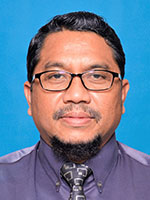Speakers

Dr. Mohamad Yatim SAARI
Deputy Head, Rehabilitation Medicine services, Ministry of Health, Malaysia
Head, Rehabilitation Medicine Department, Serdang Hospital, Malaysia
MD (USM, Malaysia); Master of Rehabilitation Medicine (UM, Malaya)
Dr Saari Mohamad Yatim graduated with MD from University of Sciences, Malaysia and obtained his Master Degree in Rehabilitation Medicine from University of Malaya, Kuala Lumpur. He is then pursuing his area of interest study in Cardiopulmonary Rehabilitation at Medical Department, Tung Wah Hospital, Hong Kong and Chonbuk University Hospital, Korea.
Dr Saari sits on several committees locally and internationally. He is currently the Deputy Head of Rehabilitation Medicine services in the Ministry of Health, Malaysia and the Head of Rehabilitation Medicine Department, Serdang Hospital, Selangor. He is also sit as executive board members of Asia-Oceanian Society of Physical and Rehabilitation Medicine and AsiaPRevent.
Abstract
Model of Pulmonary Rehabilitation for Chronic Heart Failure
Chronic heart failure (CHF) and chronic obstructive pulmonary disease (COPD) patients commonly suffer from exertional symptoms of breathlessness and fatigue. The similar systemic manifestations of the conditions, including skeletal muscle dysfunction, are a major contributing factor to the limitation in exercise capacity. A period of exercise training has been shown to improve exercise performance and health-related quality of life for both conditions. Exercise training is a key component of pulmonary rehabilitation (PR) which is now a standard of care for patients with COPD and is symptom based. Although it may be assumed that patients with CHF could be incorporated into cardiac rehabilitation, this is predominantly a secondary prevention programme for patients who are largely asymptomatic. It has been shown that patients with CHF can be successfully trained together with patients with COPD by the same therapists within PR. There are comparable outcome measures that can be used for both COPD and CHF. Many patients with CHF still do not have access to an exercise rehabilitation programme and incorporating them into the PR model of care could be one solution.
